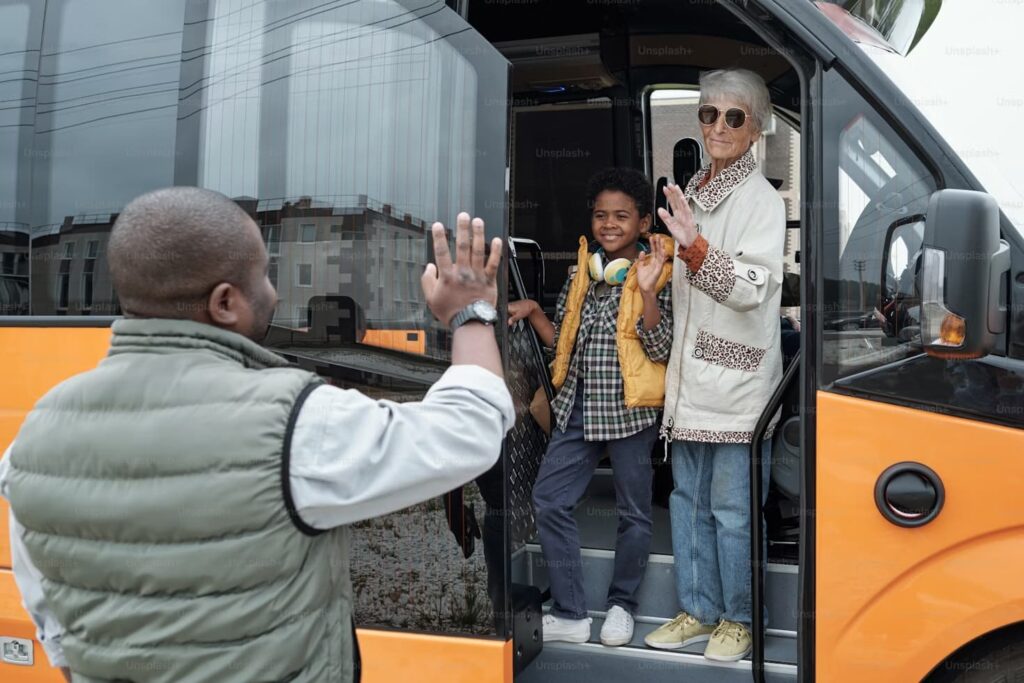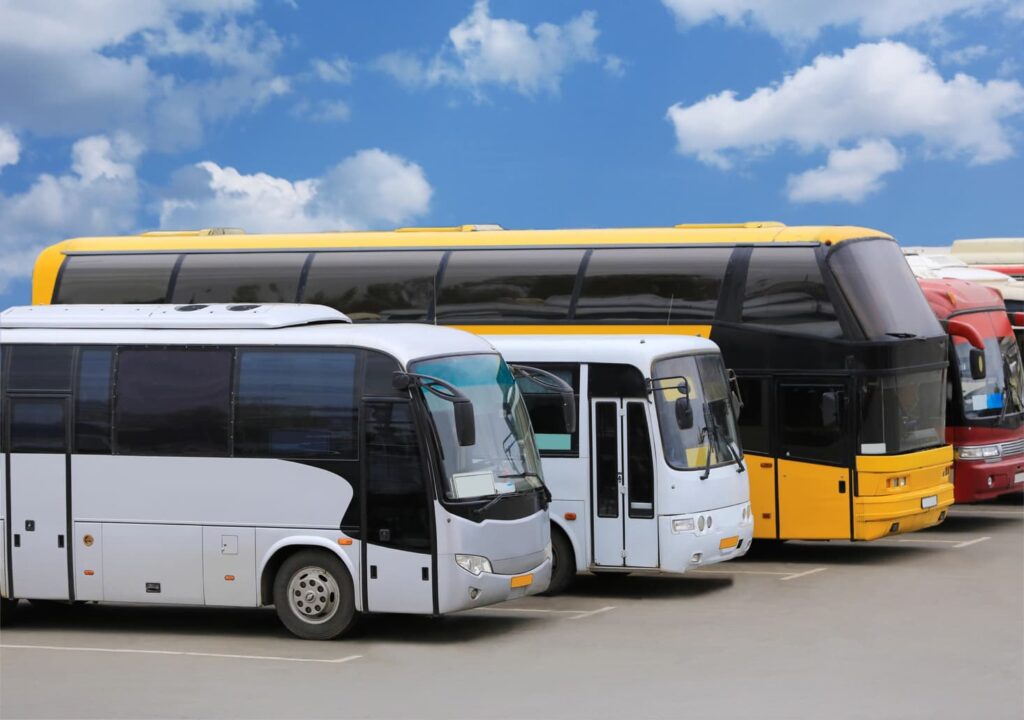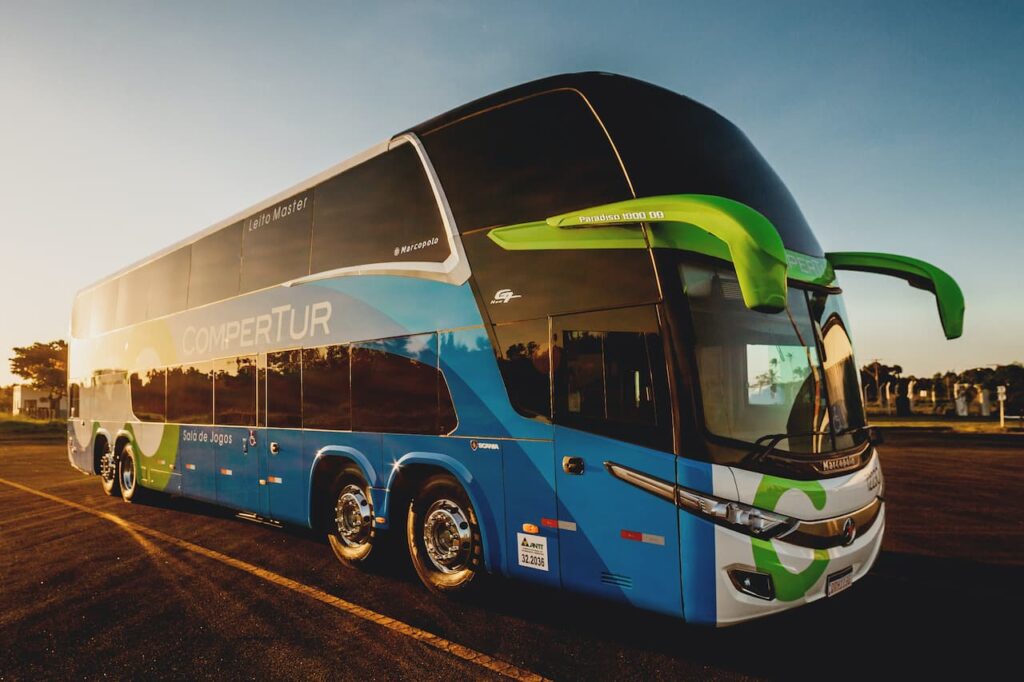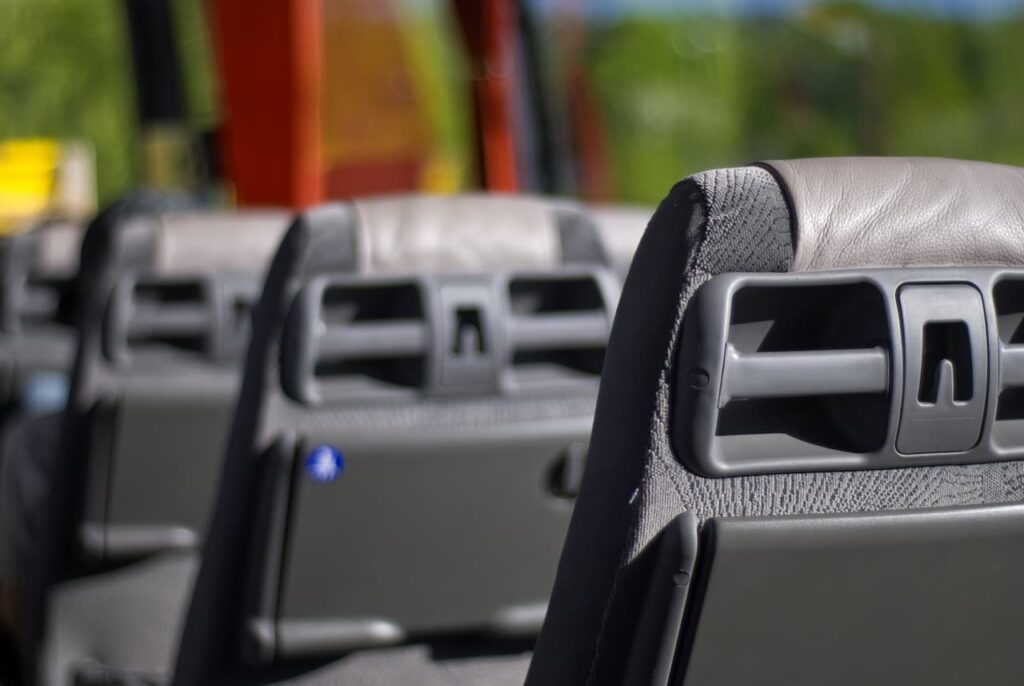The post What to See in North America by Bus appeared first on L-T@HOE_TRANS_IT.
]]>The Majestic Pacific Northwest
Seattle’s Urban Charm
Start your bus rental journey in Seattle, Washington, where you can explore the famous Pike Place Market and the Space Needle. The city offers a blend of urban attractions and natural beauty, perfect for any traveler.
Portland’s Quirky Culture
A short ride south takes you to Portland, Oregon. Known for its artsy vibe and excellent food, Portland is a city where you can easily spend a day walking through eclectic neighborhoods and enjoying local coffee shops and breweries.
The Oregon Coast
From Portland, head west to the Oregon Coast and experience the rugged cliffs, scenic vistas, and quaint coastal towns like Cannon Beach and Newport.

California Dreaming
San Francisco’s Golden Gate
No bus tour on the west coast is complete without a stop in San Francisco. The Golden Gate Bridge, Alcatraz Island, and the historic cable cars offer memorable experiences that are quintessentially Californian.
Los Angeles’ Star Power
Travel down to Los Angeles to soak in the Hollywood glamour. Visit the Walk of Fame, the Hollywood Sign, and perhaps even catch a glimpse of a celebrity.
San Diego’s Sunny Shores
Finish your California tour in San Diego, where the beautiful beaches and the famous San Diego Zoo provide a relaxing end to your southern California adventure.
The Great American Southwest
Grand Canyon National Park
One of the seven natural wonders of the world, the Grand Canyon is a must-see. Its immense size and intricate landscapes are truly breathtaking and offer plenty of hiking, photography, and sightseeing opportunities.

Monument Valley
Further east, the sandstone buttes of Monument Valley depict classic images of the American West. Known for its dramatic landscapes and rich Native American history, it’s a place where you can take stunning photos and learn about Navajo culture.
The Heart of Texas
San Antonio’s River Walk
In Texas, San Antonio’s famous River Walk offers a unique urban experience with its riverside cafes, shops, and festivals. Don’t miss the historic Alamo, a key site in Texas history.
Austin’s Live Music Scene
Austin, the state capital, is known as the “Live Music Capital of the World.” Catch a show in one of the many bars or during a city-wide music festival.
The Historic East Coast
Washington D.C.’s Monuments and Museums
On the East Coast, Washington D.C. is packed with free museums and historic sites. The Smithsonian museums, the Lincoln Memorial, and the Capitol are just a few key highlights.
New York City’s Endless Attractions
Further north, New York City awaits with its bustling streets, Broadway shows, and landmarks like the Statue of Liberty and Central Park.
Boston’s Colonial History
Finish your East Coast tour in Boston, where historic sites from the American Revolution, like the Freedom Trail and Boston Tea Party Ships, offer a glimpse into the nation’s founding.
Tips for Bus Travel in North America
- Plan Ahead: Research bus routes and schedules, especially those that offer scenic views or convenient stops at major attractions.
- Pack Smart: Bring essentials for long journeys, including a travel pillow, snacks, water, and entertainment.
- Stay Flexible: Sometimes, bus schedules can change. Keeping a flexible travel plan can help you make the most of your trip.
- Use Stopovers Wisely: Use longer stops to explore cities or relax before continuing your journey.
Traveling by bus across North America allows you to see a wide range of attractions at your own pace, often with the added bonus of meeting fellow travelers. Whether it’s through rugged natural landscapes, bustling metropolitan areas, or historical sites, a bus journey offers a unique and enriching way to experience the beauty and diversity of North America.
The post What to See in North America by Bus appeared first on L-T@HOE_TRANS_IT.
]]>The post How to Travel with a Big Group in the US appeared first on L-T@HOE_TRANS_IT.
]]>Understand Your Group’s Needs
Before booking a charter bus, it’s crucial to understand the specific needs of your group. Consider the size of your group, the age range of the passengers, and any special requirements such as wheelchair access or onboard entertainment systems. Knowing these details upfront will help you choose the right bus type and amenities that will make the trip enjoyable for everyone.
Choosing the Right Charter Bus Company
When selecting a charter bus company, look for reputable providers with positive reviews and a strong safety record. It’s essential to check that they are licensed and insured. Ask about the experience of their drivers and the maintenance record of their fleet. A good company should be transparent about their services and willing to answer all your questions.
Plan Your Route and Schedule
Planning your route and schedule in advance is vital. Discuss with the charter company the most scenic or efficient routes, depending on your group’s preferences. Make sure there are ample stops scheduled for meals, restroom breaks, and to stretch legs. Being clear about your itinerary will help prevent any misunderstandings and ensure a smooth trip.
Amenities and Comfort
Modern charter buses offer a range of amenities to make your journey more comfortable. These might include Wi-Fi, power outlets, reclining seats, and onboard restrooms. Some buses also offer DVD players and mini fridges. When booking, consider what amenities your group will appreciate during the journey, especially if it’s a long trip.

Budgeting for Your Trip
The cost of renting a charter bus can vary widely depending on the size of the bus, the distance you are traveling, the time of year, and the duration of your rental. To get the best value, obtain quotes from several companies and ask about any additional fees such as for mileage, driver accommodation, or late-night driving. Don’t forget to factor in the cost of meals and any planned activities during the trip.
Communication is Key
Effective communication is essential when traveling with a big group. Ensure all group members are aware of the travel details, including departure times, pick-up points, and the itinerary. Consider using a mobile app or group chat to keep everyone updated in real-time about any changes or important information during the trip.
Safety Measures
Safety should always be a priority. Verify that the charter bus company complies with all national and state regulations. Check that they provide safety features like seat belts and first aid kits. During the journey, remind your group about the importance of following safety guidelines, especially when embarking and disembarking from the bus.
Packing Tips for Group Travel
Encourage your group to pack light to ensure there is enough space for everyone’s luggage. It’s helpful to provide a packing list that includes items like comfortable clothing, chargers, snacks, water bottles, and travel pillows. Also, consider the weather and any specific activities planned during the trip that may require special attire or equipment.
Making Memories
Finally, remember that traveling with a group is not just about reaching your destination—it’s about the experience. Plan some interactive games or onboard entertainment to keep the atmosphere lively and engage your fellow travelers. Don’t forget to take lots of photos and maybe even keep a travel journal to document your adventures!
Conclusion
Organizing a trip for a big group using a charter bus rental in the US can be a breeze with the right planning and preparation. By following these tips, you can ensure a comfortable, safe, and enjoyable travel experience that your group will remember for years to come. Enjoy your journey across the beautiful landscapes of the United States, knowing that you’ve got the logistics down to an art!
The post How to Travel with a Big Group in the US appeared first on L-T@HOE_TRANS_IT.
]]>The post All About Buses in America appeared first on L-T@HOE_TRANS_IT.
]]>In this article, we will look at the different types of buses in America, their impact on daily life, and the future of bus transportation in the country.
Public Transit Buses
Public transit buses are the most common type in America, serving as a critical component of urban transportation networks. These buses are typically operated by local transit authorities and provide scheduled service along fixed routes within a city or metropolitan area. Some of the largest public bus systems in the United States include:
- New York City Transit Authority (MTA)
- Los Angeles County Metropolitan Transportation Authority (Metro)
- Chicago Transit Authority (CTA)
- Washington Metropolitan Area Transit Authority (WMATA)
Public transit buses are essential for many Americans, particularly those who do not own a car or prefer not to drive. They help reduce traffic congestion, lower carbon emissions, and provide access to jobs, education, and essential services for millions of people.
Intercity Bus Services
Intercity bus services, such as Greyhound and Megabus, connect cities and towns across the United States. These buses offer an affordable alternative to air and rail travel, with routes covering both short and long distances. Some popular intercity bus routes include:
- New York City to Washington, D.C.
- Los Angeles to San Francisco
- Chicago to Detroit
- Atlanta to Orlando
Intercity buses often feature Wi-Fi, power outlets, and onboard restrooms, making long-distance travel more comfortable for passengers. Additionally, many intercity bus companies offer express services between major cities, reducing travel times and providing a more convenient option for travelers.
School Buses
School buses are integral to the American education system, transporting millions of students to and from school daily. These iconic yellow buses are designed with safety features such as reinforced sides, high seat backs, and stop arms to ensure the well-being of children during their daily commutes.
In the United States, school buses must meet safety standards set by the National Highway Traffic Safety Administration (NHTSA). These standards cover various aspects of bus design, including emergency exits, lighting, and structural integrity.
Charter Buses
Charter buses are a popular choice for group travel, offering a convenient and cost-effective way to transport many people for events, tours, and other activities. These buses are often used for:
- Corporate events and conventions
- Weddings and family reunions
- Sporting events and team travel
- Field trips and educational tours
Charter buses have seating, climate control, and ample storage space for luggage and equipment. They are ideal for groups looking to travel together while avoiding the hassle of driving and parking multiple vehicles.
Shuttle Buses
Shuttle buses are commonly used to transport passengers between airports, hotels, and tourist attractions. These buses provide frequent, short-distance service and are often operated by private companies, hotels, or airports. Shuttle buses offer a convenient and cost-effective way for travelers to move between critical destinations without needing a personal vehicle.
Many shuttle bus services are designed to accommodate passengers with luggage, offering ample storage space and easy access to major travel hubs. Some shuttle buses also feature wheelchair lifts and other accessibility features to ensure passengers can travel comfortably.
Specialty Buses
Specialty buses encompass a wide range of vehicles designed for specific purposes, such as:
- Mobile medical clinics and blood donation centers
- Mobile libraries and bookmobiles
- Mobile command centers for emergency response
- Mobile food banks and community outreach
Nonprofit organizations, government agencies, and private companies often operate these buses to deliver services to communities nationwide. They are critical in reaching underserved populations and providing access to resources that may not be readily available in certain areas.

The Future of Buses in America
As technology advances and concerns about environmental sustainability grow, the future of buses in America will likely involve a shift toward electric and hybrid vehicles. Many cities and transit authorities are already investing in electric buses, which produce zero emissions and have lower operating costs than their diesel counterparts.
Furthermore, integrating intelligent technology, like real-time tracking and mobile ticketing, is expected to improve the passenger experience and the efficiency of bus systems across the country. As these innovations continue, it is clear that buses will remain a critical component of the nation’s transportation network for years to come.
The post All About Buses in America appeared first on L-T@HOE_TRANS_IT.
]]>The post What to choose for a trip: bus or minibus? appeared first on L-T@HOE_TRANS_IT.
]]>Advantages of minibus traveling
Travelling by minibus has a lot of advantages. If the group of people is small, there is no sense to take a big bus, because it consumes much more gasoline.
In minibuses often go on a trip companies, the members of which are well acquainted. The number of seats in such cars varies from 5 to 14. The advantages of the minibus include:
- maneuverability;
- speed;
- compactness.
A minibus is essentially a passenger car, only more spacious.
This kind of transport does not require a lot of space during stops. A minibus will pass through where the bus can not pass, for example, in the mountainous terrain. Maneuverable transport fits perfectly into the busy traffic on city highways. When renting it, you can build a route yourself, provide for stops and traffic schedule.
One and the same way by van can be overcome faster than by bus.
Disadvantages
Vans usually have limited space for passengers and their luggage, which can be inconvenient for long trips or for those traveling with large luggage. Also, minibuses usually don’t have the same comfort as buses or trains, especially if they are used for long trips.
Advantages of traveling by bus
The bus also has many advantages, it is convenient to travel by bus. Many people take it on excursions. This is the best choice for large groups of 20 or more people.

Buses practically do not depend on weather conditions, they continue their way in rainy weather and in strong winds, when, for example, planes do not fly.
Traveling by such transport, you can save money. The bus ticket will cost many times cheaper than the train or plane.
You can go on a trip with a solid company.
Buses are considered more convenient compared to minibuses, because they have more space. Passengers can safely stretch their legs. Many modern buses have WI-FI, phone charging and even a toilet. They are ideal for long trips.
When traveling by bus, you can take more luggage. In such transport there is a special luggage compartment – things do not need to be stored in the cabin, cramped.
Special mention should be made of double-decker buses designed for large tourist groups.
Disadvantages
Traveling by bus can take much longer than traveling by car, train or plane, especially if there is a significant distance to travel. This can be very inconvenient, especially for those who have limited time.
Conclusion
Travelers are attracted both by buses and minibuses. Both the one and the other type of transport is well suited for excursions. Buses are convenient to travel long distances in large groups, to other cities and even countries. In them, as in minibuses, you can sleep, read, listen to music, watch TV. They are equipped with air conditioning, they are comfortable to travel on at any time of year. Both transports are extremely popular, especially on holidays. Weekend bus tours attract travelers by their affordable price and interesting excursion programs. Minibuses are also rented for weddings and school trips. This type of transport is good for its maneuverability, it is often used for excursions in the mountains. Deciding what to go on a trip, compare the advantages of each option.
The post What to choose for a trip: bus or minibus? appeared first on L-T@HOE_TRANS_IT.
]]>The post What do you do on a bus tour when you’re on the road? appeared first on L-T@HOE_TRANS_IT.
]]>Studying
The answer to the question, what to do on the bus? – is simple, you can use your free time to study. This option is suitable not only for students. You can, for example, gather information on a topic of interest for further promotion or a change of profession. Someone is interested in how to do hair, and someone the new trends in creating manicures.
Read
If traveling by bus is boring – try reading. An interesting book is sure to be found. You can take a paper edition with you on the road or download an electronic version. A long road is the perfect time to reread your favorite work or get acquainted with a new one, recommended by friends, someone from the family or a colleague.
Playing on your phone
Many people like to play on their phones while on the road. The main thing is to have a place to charge it, so that at the most inopportune moment you won’t be without a connection. Some people like to play solitaire, while others prefer complex games. This bus leisure option is ideal for young travelers, but sometimes older people don’t mind playing on the phone.

Watching a movie or TV series
Traveling by bus is great for watching a movie or TV series. Many vehicles have a small TV in the cabin – ask the driver to turn on something interesting. But there is no guarantee that the movie will be to your liking. It is better to download something to your tablet in advance.
Daydreaming
Bus tour gives you the opportunity to dream, to be given to pleasant thoughts. Many are on the way begin to imagine that they arrived at their destination – splashing in the sea, sunbathing, or sightseeing. Another good option is to start planning your next trip. Try to focus on good thoughts, and the time will fly by quickly.
Sleep
Most travelers don’t mind sleeping on the road. They use the trip to rest and arrive at their destination full of energy. Sleeping on the bus does not work for everyone, but if the road is long, you can take a nap at least a few hours. Once you arrive at your destination, you won’t have to waste time sleeping, and you can go straight to business or sightseeing after checking into the hotel.
Listen to music
Listening to music will help you relax on the road. Download a few songs on the phone in advance and do not forget to take headphones, so as not to disturb others. While on the road, you can listen to music and look out the window.

Drawing
Some people manage to draw on the road. This desire usually appears in people with artistic skills. They capture on paper, what they see out the window and during stops. It can be a sketch or an idea for a big picture. The main thing is not to forget to bring sheets of paper and pencils. Drawing is a leisure activity that is sure to appeal to children. Thanks to this activity the kids will be less cranky on the road.
Work
If possible, try to work on the road. This option is suitable for those who did not have time to finish something before the trip and do not want to waste time. On the road you can finish a project, make a plan for upcoming events, write several articles. The work on the road is unlikely to be fruitful, but you can do something.
Get acquainted with fellow travelers
Many travelers are eager to get acquainted with fellow travelers, communicate with them on various topics. This is a great opportunity to make new friends, especially if it’s a tourist trip. The earlier the meeting takes place, the greater the chance that the trip will be interesting.
The post What do you do on a bus tour when you’re on the road? appeared first on L-T@HOE_TRANS_IT.
]]>The post The Future of Bus Transportation in the U.S. appeared first on L-T@HOE_TRANS_IT.
]]>Challenges facing the current bus transportation system
One of the main challenges facing the current bus transportation system in the U.S. is congestion and infrastructure issues. Many bus routes are slowed down or disrupted by traffic, making it difficult for buses to operate efficiently and on schedule. This can lead to frustration for passengers and can discourage people from using the bus as their primary form of transportation.
Another challenge is funding and budget constraints. Many public transit agencies, which operate bus systems, are facing budget cuts and limited resources, which can make it difficult to invest in new technologies and infrastructure improvements.
In addition, buses face competition from other forms of transportation, such as ride-hailing services and light rail systems, which can make it difficult for buses to attract and retain riders.
In addition to congestion and infrastructure issues, there are several other challenges facing the current bus transportation system in the U.S.
One of these challenges is the lack of accessibility for people with disabilities. Many buses are not equipped with features such as wheelchair ramps or audio announcements, making it difficult for people with disabilities to use the bus as a form of transportation.
Another challenge is the lack of connectivity with other modes of transportation. In many cases, bus routes do not align with train or subway systems, making it difficult for passengers to easily transfer between modes of transportation. This can be a major inconvenience for passengers and can discourage people from using the bus.
There is also the issue of safety and security on buses, which can be a concern for passengers. Incidents of crime or accidents on buses can discourage people from using the bus as a form of transportation.
Finally, there is the issue of funding and sustainability for the bus transportation system. As previously mentioned, many public transit agencies are facing budget constraints, which can make it difficult to maintain and improve the bus system. There is also the issue of rising fuel costs, which can impact the operating costs of the bus system.
Overall, there are many challenges facing the current bus transportation system in the U.S., and addressing these challenges will be essential in order to improve the future of bus transportation in the country.
Potential solutions for improving the future of bus transportation
There are a number of potential solutions that could help to improve the future of bus transportation in the U.S. One solution is the increased use of electric buses and other emerging technologies, such as smart transit systems, which can improve efficiency and reduce emissions.
Another solution is the creation of dedicated lanes and priority for buses on roads, which can help to reduce congestion and improve reliability. This could be done through the use of bus rapid transit (BRT) systems, which use dedicated lanes and other infrastructure improvements to speed up bus travel.
In addition, creative financing options, such as public-private partnerships and congestion pricing, could be used to fund improvements to the bus transportation system.
Case studies of successful bus transportation initiatives in the U.S.
There are several examples of cities and regions in the U.S. that have implemented successful initiatives to improve bus transportation. For instance, the city of Portland, Oregon has implemented a BRT system called the MAX, which has helped to improve travel times and increase ridership on the city’s bus system.
Another example is the Miami-Dade County bus system in Florida, which has invested in a fleet of electric buses and has implemented a smart transit system that uses real-time data to improve efficiency.
Conclusion
In conclusion, the future of bus transportation in the U.S. is facing a number of challenges, including congestion, funding constraints, and competition from other forms of transportation. However, by investing in new technologies, such as electric buses and smart transit systems, and implementing creative financing options, it is possible to improve the efficiency and sustainability of the bus transportation system and ensure that it remains a vital part of the transportation landscape in the U.S.
The post The Future of Bus Transportation in the U.S. appeared first on L-T@HOE_TRANS_IT.
]]>The post Exploring the History of Buses and Bus Routes in the U.S. appeared first on L-T@HOE_TRANS_IT.
]]>The Early History of Buses in the U.S.
The first bus routes in the U.S. can be traced back to the early 19th century when horse-drawn omnibuses were introduced in major cities such as New York and Philadelphia. These early buses were often cramped and uncomfortable and could only travel at a slow pace due to the limitations of horsepower. Despite these drawbacks, buses quickly gained popularity as a cheap and convenient way for people without access to horses or carriages to travel around the city.
As the population of the U.S. grew and urbanized in the late 19th and early 20th centuries, the demand for bus transportation increased. In the early 20th century, motorized buses began to appear on American roads, replacing the horse-drawn omnibuses of the past. These new buses were faster and more reliable and helped to expand the reach of bus routes to more rural areas.
The Rise of the Modern Bus Industry.
In the mid-20th century, the bus industry in the U.S. underwent a major transformation. Large bus companies, such as Greyhound and Trailways, emerged and began to operate long-distance routes across the country. These companies introduced several technological innovations, such as air conditioning and the use of diesel engines, which made bus travel more comfortable and efficient.
In addition to the expansion of long-distance routes, the mid-20th century also saw the development of urban and suburban bus systems in many cities across the U.S. These systems were designed to provide affordable and convenient transportation for people who lived and worked in the city and helped to reduce traffic congestion and air pollution.
The Challenges Facing the Bus Industry Today.
Despite the many benefits of bus transportation, the industry has faced a number of challenges in recent years. One major challenge is competition from other forms of transportation, such as airlines and trains, which can offer faster and more convenient travel options for long-distance trips. In addition, economic and regulatory factors, such as the high cost of fuel and the challenges of obtaining permits for new routes, can make it difficult for bus companies to maintain profitability.
Future of Bus Transportation in the U.S.
Despite these challenges, the future of bus transportation in the U.S. is bright. In recent years, there has been a growing trend toward the adoption of electric buses, which offer a cleaner and more efficient alternative to traditional gasoline-powered buses. In addition, many cities are exploring the integration of bus transportation with other forms of public transportation, such as light rail and bike-sharing programs, to create more comprehensive and convenient transportation networks.
Writing essay about the history of buses and bus routes in the U.S.
Writing essays about the history of buses and bus routes in the U.S. can be a fascinating and enlightening experience for students. Through research and analysis, students can gain a deeper understanding of the key events and milestones that have shaped the development of bus transportation in the U.S. over the past century.
Students can explore the early history of buses in the U.S., tracing the development of horse-drawn omnibuses in the 19th century to the motorized buses of the early 20th century. They can also consider the factors that led to the rise of the modern bus industry in the mid-20th century, such as the expansion of long-distance routes and the development of urban and suburban bus systems.
In addition to the technological and economic factors that have impacted the bus industry, students can also examine the cultural and social significance of buses and bus routes in the U.S. For example, they might consider how buses have played a role in connecting and serving marginalized communities, or how they have been depicted in popular culture and media.
Overall, writing essays about the history of buses and bus routes in the U.S. can provide students with a rich and diverse learning experience, helping them to better understand the complex and dynamic nature of transportation and its role in shaping our society.
https://buyextendedessay.com can provide expert assistance with researching and writing an essay about the history of buses and bus routes in the U.S. Our team of experienced writers can help you to explore the key events and milestones that have shaped the development of bus transportation in the U.S., and provide insights and analysis on the technological, economic, cultural, and social factors that have influenced the industry. Whether you need help with the research, writing, or editing process, our team is here to help you succeed.
Conclusion:
The history of buses and bus routes in the U.S. is a rich and complex one, encompassing a wide range of technological, economic, and societal changes. Despite the challenges facing the industry today, buses continue to play a vital role in the transportation landscape of the U.S. and will likely continue to do so well into the future. From the early horse-drawn omnibuses to the electric buses of today, the story of bus transportation in the U.S.
The post Exploring the History of Buses and Bus Routes in the U.S. appeared first on L-T@HOE_TRANS_IT.
]]>The post America’s most scenic bus routes appeared first on L-T@HOE_TRANS_IT.
]]>The Pacific Coast Highway
The Pacific Coast Highway bus route is one of the most popular tourist attractions in California. Every year, millions of people travel along the coast to see the beautiful scenery and experience the unique culture. If you’re planning a trip to California, here’s everything you need to know about the Pacific Coast Highway bus route.
The Pacific Coast Highway bus route runs from San Diego to San Francisco. The journey takes about 10 hours, but it’s worth it for the stunning views of the ocean and the coastal towns. Along the way, you’ll pass through Los Angeles, Santa Barbara, Monterey, and Carmel-by-the-Sea. There are also plenty of stops for photo opportunities, so make sure you have your camera ready!
If you’re looking for a more leisurely trip, there are also several day tour options available. These tours typically include stops at some of the most popular tourist destinations, such as Disneyland or Universal Studios Hollywood. Day tours are a great option if you want to experience everything that California has to offer without having to worry about finding accommodation or getting around on your own.
Route 66 – The Mother Road
Route 66, also known as the Mother Road, is one of the most iconic roads in America. Stretching from Chicago to Los Angeles, the 2,448 mile long road passes through eight states and three time zones. Originally built in 1926, the road was a way for people to travel west during the country’s westward expansion. Today, the road is a popular tourist destination for those looking to experience a piece of American history. Route 66 is also a popular essay topic in US schools and colleges. https://ibstudenthelp.com offers essay writing services for students who need help writing about this topic or any other topic related to their IB diploma.
The route begins in Chicago, Illinois and ends in Santa Monica, California. Along the way, there are many attractions and sights to see. Some of the most popular stops include the Cadillac Ranch in Amarillo, Texas, the Petrified Forest National Park in Arizona, and the Painted Desert. There are also many small towns along the route that have their own unique charm.
If you’re planning on taking a trip down Route 66, there are a few things you should keep in mind.
First of all, the road is divided into two sections – east and west. The east section begins in Chicago and ends in Tucumcari, New Mexico. The west section picks up in Albuquerque, New Mexico and ends in Santa Monica.
Secondly, it’s important to plan your trip ahead of time as some parts of the road are less traveled than others and may not have gas stations or restaurants.
Lastly, make sure you take your time and enjoy the ride!
The Blue Ridge Parkway
The Blue Ridge Parkway bus route is a great way to see everything the parkway has to offer without having to worry about driving. The bus runs from early May through late October, and there are multiple pick-up and drop-off points along the way. You can also hop on and off at any of the parkway’s many attractions, including hiking trails, picnic areas, and scenic overlooks. Best of all, the bus is free to ride!
If you’re interested in taking the Blue Ridge Parkway bus, there are a few things you should keep in mind.
First, the bus only runs on weekdays; there is no service on weekends or holidays. Second, seating is first-come, first-served, so it’s important to arrive early if you want to guarantee a spot. Finally, please be sure to respect the other passengers and refrain from talking loudly or playing music without headphones.
The Great River Road
The Great River Road is a network of highways that follow the course of the Mississippi River. Spanning 10 states and 3,000 miles, the Great River Road is one of the longest scenic routes in the United States.
The Great River Road bus route is a great way to see the sights and sounds of the Mississippi River. The bus tour follows the river from its source in Minnesota all the way to its delta in Louisiana. Along the way, passengers will see some of America’s most iconic landmarks, including the Gateway Arch in St. Louis and Graceland in Memphis.
The Great River Road bus tour is a great way to see America’s heartland and learn about its history and culture. The tour takes approximately two weeks to complete, and reservations can be made online or by calling 1-800-BUS-RIDE.
There are many reasons to take the Great River Road bus tour.
First and foremost, it’s a great way to see America’s heartland. The bus tour takes passengers through 10 different states, each with its own unique history and culture. In addition, the bus tour follows the path of the mighty Mississippi River, one of America’s most iconic waterways.
Another great reason to take the Great River Road bus tour is that it’s an affordable way to travel. The cost of the tour includes your transportation, lodging, and meals. You’ll also have a professional tour guide with you throughout the journey to answer any questions you may have about the places you’re visiting.
Conclusion
While there are many scenic bus routes in America, the four mentioned above stand out for their natural beauty and historical significance. The Pacific Coast Highway offers stunning ocean views, Route 66 is a legendary road with rich cultural heritage, the Blue Ridge Parkway boasts breathtaking mountain scenery, and the Great River Road follows the mighty Mississippi River. Whether you’re looking to experience America’s natural wonders or explore its vibrant history, these bus routes offer an unparalleled travel experience.
The post America’s most scenic bus routes appeared first on L-T@HOE_TRANS_IT.
]]>The post How to choose the perfect camping bus for a big family appeared first on L-T@HOE_TRANS_IT.
]]>Size is key – make sure to pick a bus that’s big enough for your family
One of the most important things to consider when choosing a camping bus is size. You need to make sure that the bus is big enough to comfortably accommodate your entire family, as well as all of your gear. If you have a large family, or if you like to bring along a lot of gear, you’ll need to make sure you choose a bus that’s on the larger side. Otherwise, you might find yourself feeling cramped and uncomfortable on your trip.
Consider Your Budget
Of course, budget is always a consideration when making any major purchase. Camping buses can range in price from a few thousand dollars to tens of thousands of dollars. So, it’s important to have a good idea of how much you’re willing to spend before you start shopping around. Once you’ve established your budget, you can start looking at buses that fall within your price range.
Consider the features you need – like bathrooms, kitchens, and beds
Bathrooms
The number of bathrooms you need in your camping bus will depend on the size of your family and how long you’ll be on the road. A good rule of thumb is one bathroom for every four people. So if you have a family of four, you’ll want at least one bathroom. If you’re planning on being on the road for more than a week, you might want to consider adding an extra bathroom. That way, everyone will have plenty of space to get ready in the morning without feeling cramped.
Kitchens
You also need to think about how many kitchens you need in your camping bus. If you’re only going to be cooking simple meals, then one kitchen will probably be enough. But if you’re planning on doing a lot of cooking or entertaining, then you might want to consider adding a second kitchen. This will give you plenty of space to work in and will make mealtime a lot more enjoyable.
Beds
Finally, you need to think about how many beds you need in your camping bus. If everyone in your family is comfortable sleeping in the same room, then you can probably get by with just one bed. But if you want everyone to have their own space, then you’ll need to add more beds. A good rule of thumb is one bed for every two people. So if you have a family of four, you’ll want at least two beds.
Test drive different buses to see which one feels best
The minivan is a popular choice for campers because it’s relatively small and easy to maneuver. Plus, it gets good gas mileage, which is important if you’re going to be doing a lot of driving. However, one downside of the minivan is that it doesn’t have a lot of storage space. So, if you’re planning on bringing a lot of gear with you on your trip, you might want to consider another option.
An SUV is a good choice for campers who want more space than what a minivan has to offer. Plus, SUVs tend to have more features than minivans, such as four-wheel drive and better ground clearance. However, one downside of an SUV is that it can be more difficult to drive than a smaller vehicle like a minivan. And, of course, SUVs also get worse gas mileage than smaller vehicles.
If you really want to go all-out on your next camping trip, then you might want to consider renting an RV. RVs come in all shapes and sizes, so you can find one that’s perfect for your needs. Plus, RVs have all the amenities you could possibly want – from kitchens to bathrooms to bedrooms. However, RVs can be very expensive to rent, and they can also be difficult to drive if you’re not used to handling a large vehicle.
Conclusion
With these guidelines in mind, you should be well on your way to choosing the perfect camping bus for your family. Just remember to keep the size of your family in mind, consider what features you need, and find a bus that fits both your budget andyour needs. And finally, don’t forget to take it for a test drive! With a little bit of research, you’ll be sure to find the perfect camping bus for your next big adventure.
The post How to choose the perfect camping bus for a big family appeared first on L-T@HOE_TRANS_IT.
]]>The post Buses in North America appeared first on L-T@HOE_TRANS_IT.
]]>The first bus in North America in our understanding was released in 1900 by Mack and was called the Touring Coach. It was equipped with a 4-cylinder engine, which allowed it to accelerate to 30 km / h, and a 3-speed gearbox. The bus had 27 seats, i.e. it was far from tiny. By the way, we will meet with the name of this company more than once. In general, its bus products, as well as heavy trucks, have always had an avant-garde design and a very original appearance. The first bus in excellent condition has survived to this day and is on display at the factory museum in Allentown.
Mack, 1900
In 1903, Fischer signed a contract with the London Bus Company to supply several buses for the English capital. Perhaps this fact would not have deserved our attention in the “American context”, but the design of the car was such that it was simply impossible not to dwell on it. The bus had a hybrid drive – this is at the beginning of the last century! The rear wheels were driven by a 10-horsepower electric motor (each), which was powered by a 15 kW generator. That, in turn, was driven by a 20-horsepower 4-cylinder internal combustion engine, and the batteries connected to the network between the generator and the traction motors served as an energy storage device. Due to the complexity of the design, the bus did not perform well and was returned to the United States.
The year 1910 has come. Buick, known today for its luxurious cars, has released Motor Bus – mind you, a wagon layout. Two-cylinder boxer engine with 22 hp. located in front and allowed a small bus to accelerate to 40 km / h. This 12-seat car was mainly used by hotels and train stations. But as the reader sees, she has already laid the foundation for the wagon layout.
Buick Bus, 1910
The transport company Greyhound was soon founded (1914), which today successfully competes with rail passenger transport. With the massive construction of highways on the North American continent, the possibility of transcontinental road passenger flights immediately arose, and routes were laid in such a way as to cover almost all states from East to West and from North to South. Comfortable multi-seat buses appeared with special low-frame chassis and special pneumatic shock absorbers, which provide a smooth ride much greater than rail transport could offer. Europe did not have to participate in such a competitive struggle, and America began its victorious march on wheels on asphalt. In addition, bus stations, scattered in the most unexpected places,
Modern Motor Coaches, 1927
Interestingly, Greyhound not only operated buses, but also made investments in the development of new rolling stock that met its requirements. Almost all American bus and truck manufacturers of that time participated in these developments, until the circle narrowed down to a few companies, and the emblem of the manufacturer himself, as a rule, was absent – it was replaced by the image of a greyhound. An example is the 1927 Modern Motor Coaches 26-seat bus. The buses of those years have pneumatic shock absorbers, purely American horns, routes written on the sides and, of course, a clearly visible image of the legendary greyhound.
Around the same time, buses with a stepped roof appeared in the USA (the European name “hohdecker” does not fit here). The 1925 ACF bus was one of the first such vehicles in the New World. Although the European company Gebruder Ludewig credits itself with the invention of such a body after the end (!) of the Second World War.
ACF, 1925
In the 1930s, small luxury buses on an extended passenger car chassis became popular. One of them is a 12-seater Fitzjohn Sedan-Bus built on a Chevrolet chassis for a transport company. Despite their small size, these bus-cars traveled through Alaska, the United States and Mexico. And even with such a small passenger capacity, trips across North America were very profitable and convenient. Please note that the favorite chrome and polished aluminum trim of most buses is not yet available.
Fitzjohn Sedan-Bus, 1930s
And a few more words about pre-war buses. Or rather, their design. It’s not about the original coloring, but about the sculpture of the object. Here, for example, Fitzjohn 1939. It is easy to see that the character of some surfaces was influenced by a passenger car. Yes, yes, it is light. Pay attention to the front fenders. One gets the impression that they were purely mechanically transferred to the bus body from a passenger car, and a real sculpture “appeared”. Quite a few American bus companies used this technique at that time, but this period passed rather quickly. Most likely, it was just a tribute to fashion.
Fitzjohn, 1939
A few words about the city bus. In the United States in the 20s and 30s, double-decker buses were quite common on the streets of large cities. Some firms produced them before the start of World War II. But, by and large, in the presence of a huge fleet of private cars and a rather weak development of public urban transport, the need for such cars has disappeared by itself. By the way, many American cities still do not have a developed public transport infrastructure. But, nevertheless, the most interesting designs of the city bus appeared from time to time.
New York Double Decker
For example, the articulated Twin-Coach of 1938. I would say “conditionally articulated”, since the semi-trailer of this bus did not move to the right or left in the turn, as we are used to, but only followed the terrain, swaying in a vertical plane. The life of this “misunderstanding” due to an ill-conceived concept was short-lived.

Twin Coach, 1938
The post-war GM, nicknamed the New Look, which appeared in 1960, was a purely city car, although it was often used on transit flights. The main differences of the bus were: a multi-section windshield, twin headlights, a moderate amount of polished aluminum and stainless steel, and a pair of sloping side windows between the doors. The engine was located at the rear, but experiments were carried out with a gas turbine and even with a steam engine. The bus was produced for several decades with minor changes.
GM New Look, 1960
In 1956, the Mack company, already known to us, manufactured an experimental ADS-1 city bus based on sketches by designer Alex de Szachnowski. The bus has been called “the transport of the future”. Today it is quite difficult to look at this creation without a smile, but then he made a considerable impression on the viewer. Smooth curves organized unfamiliar surfaces, bold glass patterns betrayed the originality of the designer’s thinking. In a word, ADS-1 became an event not only in the American, but also in the world bus industry. Unfortunately, the only copy built died in a fire.
The post Buses in North America appeared first on L-T@HOE_TRANS_IT.
]]>